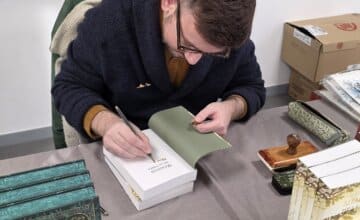Looking Beyond Borders : Construire des ponts entre les disciplines… L’avenir de l’enseignement supérieur
– English version hereunder –
Au premier semestre de l’année académique 2021-2022, Anye Miermont (FPSE), Chaïma Seddiki (FAU), Emilie Telle (FPSE), Luca Tiberi (FPSE) et Julie Walaszczyk (FTI) ont organisé une série d’ateliers en anglais au cours desquels des étudiant·e·s de BAC3 en architecture et des étudiant·e·s de master en psychologie ont travaillé ensemble sur le thème de la frontière. Un événement final a eu lieu le 10 février 2022 au MUMONS pour célébrer le travail des étudiant·e·s et présenter les nombreuses interprétations que les groupes ont proposées sur le thème choisi.
Quels étaient les objectifs ?
Les étudiant·e·s de différentes disciplines ont très peu d’occasions d’interagir les un·e·s avec les autres ou de partager des perspectives sur un sujet donné, et encore moins par l’utilisation d’une deuxième ou troisième langue. Ce projet a donc créé un espace où des étudiant·e·s de différents horizons ont pu co-construire des connaissances, pratiquer leur anglais et apprendre les un·e·s des autres dans un environnement d’apprentissage « sans stress » où les erreurs (de langage) étaient permises, l’expérimentation encouragée, les questions posées et les risques pris.
Des ressources en ligne ont été partagées avant chaque session, et différent·e·s intervenant·e·s ont été invité·e·s à apporter leur éclairage sur le thème de la frontière : Benjamin Thiry, chercheur en psychologie légale et travaillant dans les prisons, a présenté une brève histoire des frontières psychologiques et physiques, amenant les étudiant·e·s à réfléchir sur le besoin humain de créer des frontières. Lydia Bollen, de la Faculté d’Architecture et d’Urbanisme, a emmené les participant·e·s dans un parcours chronologique de la représentation du corps humain dans les formes d’art, en abordant une question clé : Jusqu’où les artistes peuvent-iels aller ?
Enfin, Kailas Moorthy, de DP Architects à Londres, a exploré les concepts de bien-être et de « self-care » en architecture.
Douze scénarios ont été proposés aux différentes équipes, allant des salles de consommation à moindre risque aux installations d’accueil (temporaire) pour les demandeur·ses d’asile et les réfugié·e·s, en passant par les environnements de travail pour les travailleur·ses du sexe, entre autres. Les groupes ont été invités à repenser des espaces souvent marginalisés et négligés et à discuter des défis que l’architecture peut poser en termes de bien-être et de santé mentale. L’équipe enseignante était là pour faciliter leur progression et leur fournir une assistance en cas de besoin.
Le point de vue de l’équipe enseignante
Cette première itération a été accueillie avec beaucoup d’enthousiasme. Chaïma Seddiki, de la Faculté d’Architecture et d’Urbanisme (FAU), a été ravie de rencontrer et de collaborer avec des collègues du Département de Psychopathologie Légale, et a apprécié « l’ouverture aux nouvelles idées, la dynamique entre les encadrant·e·s, le choix du thème et la qualité des interventions des intervenant·e·s ». Emilie Telle, de la Faculté de Psychologie et des Sciences de l’Éducation (FPSE), qui a participé au montage du projet, a trouvé qu’il s’agissait d’une « expérience humainement riche » et « éclairante en termes de pédagogie et de pratiques interdisciplinaires ». Pour elle, cette initiative est particulièrement pertinente pour les deux facultés, car elle permet aux enseignants de comprendre des réalités différentes et d’avoir un regard autre sur sa propre discipline. Pour conclure, Luca Tiberi (FPSE) envisage cette activité dans le cadre d’un projet plus vaste impliquant d’autres disciplines et, à terme, des universités partenaires.
Et la langue ?
L’anglais a été utilisé tout au long de l’échange, et tout le monde a joué le jeu. Pendant les ateliers, certains élèves se sont même tenus à l’utilisation de l’anglais dans la plupart des discussions et interactions autogérées du groupe. Grâce au soutien EMILE fourni, les enseignants ont pu créer un espace d’apprentissage dans lequel les élèves ont pu expérimenter la langue, quel que soit leur niveau d’anglais. Le projet a été une parfaite illustration des pratiques de code-switching (ou d’alternance codique) et de translanguaging, grâce auxquelles les étudiant·e·s ont pu alterner les langues et où la langue première, c’est-à-dire le français qui est la principale langue d’enseignement à l’UMONS, a été tolérée.
Looking Beyond Borders: Building Bridges across Disciplines…The Future of Higher Education?
An interdisciplinary teaching initiative has been set up as part of a collaboration between the Department of Forensic Psychology (Faculty of Psychology and Educational Sciences), the Architectural Design Unit (Faculty of Architecture and Urban Planning) and the CLIL Support Service (Language and Internationalisation Unit, Faculty of Translation and Interpretation).
In the first semester of the 2021-2022 academic year, Anye Miermont (FPSE), Chaïma Seddiki (FAU), Emilie Telle (FPSE), Luca Tiberi (FPSE) and Julie Walaszczyk (FTI) organised a series of workshop sessions in English during which undergraduate architecture students and Master’s students in psychology worked together on the topic of “borders”. A final event took place on 10th February 2022 at MUMONS to celebrate the students’ work and to showcase the many interpretations that the groups of students came up with on the chosen topic.
What were the objectives?
Students from different disciplines have very little opportunity to interact with each other or share perspectives on a given topic, let alone through the use of a second or third language. This project therefore created a space where students from different backgrounds could co-construct knowledge, practise their English, and learn from each other in a “stress-free” learning environment where (language) mistakes were allowed, experimentation encouraged, questions raised, and risks taken.
Online resources were shared with the students prior to each session, and different guest lecturers were invited to provide insights into the theme of borders: Benjamin Thiry, who is researcher in forensic psychology and works in prisons, gave a short history of psychological and physical boundaries, leading the students to reflect on the human need to create borders. Lydia Bollen from the Faculty of Architecture and Urban Planning took the students on a chronological tour of the representation of the human body in art forms, addressing a key question: How far can artists go?
Finally, Kailas Moorthy from DP Architects in London explored concepts of well-being and (self-)care in architecture.
Twelve scenarios were suggested to the different teams, ranging from supervised injection sites to (temporary) reception facilities for asylum seekers and refugees, and work environments for sex workers, among others. The groups were invited to rethink often marginalised and overlooked spaces and discuss the challenges that architecture can pose in terms of well-being and mental health. The teaching team were there to facilitate their progress and to provide assistance whenever needed.
Teachers’ perspectives
On the teaching team’s side, this first iteration was met with much enthusiasm. Chaïma Seddiki from the Faculty of Architecture and Urban Planning (FAU) was delighted to meet and collaborate with colleagues from the Department of Forensic Psychology, and enjoyed “the openness to new ideas, the energy of the teaching team, the chosen theme and the relevance of the guest speakers’ contributions”. Emilie Telle, from the Faculty of Psychology and Educational Sciences (FPSE), who participated in the project setup, found it “an enriching human experience” and “enlightening in terms of pedagogy and interdisciplinary practices”. For her, this initiative is particularly relevant to both faculties, as it allows teachers to understand different realities and have a fresh perspective on one’s own. On a concluding note, Luca Tiberi (FPSE) envisages this activity as part of a larger project involving other disciplines and, in the long run, partner universities.
And language?
English was used throughout the exchange, and everyone played the game. During the workshops, some students even stuck to the use of English in most of the group’s self-directed discussions and interactions. Thanks to the CLIL support provided, the teachers were able to create the learning space in which the students were allowed to experiment with the language, regardless of their English level. The project was a perfect illustration of code-switching and translanguaging practices, through which the students could alternate languages and where the L1, i.e. French being the main language of instruction at UMONS, was tolerated.



